Assessment of CMIP6 Model Performance for Air Temperature in the Arid Region of Northwest China and Subregions
Abstract
:1. Introduction
2. Materials and Methods
2.1. Study Area
2.2. Materials
2.3. Methods
3. Results and Analysis
3.1. Assessment Based on Time Series Correlation
3.2. Assessment Based on Long-Term Trend Simulation
3.3. Assessment Based on Spatial Pattern Simulation
3.4. Assessment Based on Preferred Models
3.4.1. Simulation Effect of PME on Time Series Correlation, Trend Magnitude and Spatial Pattern
3.4.2. Simulation Effect of PME on Temperature Spatial Change Trend
3.4.3. Simulation Effect of PME on Temperature Spatial Distribution
4. Discussion
5. Conclusions
Author Contributions
Funding
Institutional Review Board Statement
Informed Consent Statement
Data Availability Statement
Conflicts of Interest
References
- Solomon, S.D.; Qin, D.; Manning, M.; Chen, Z.; Miller, H.L. Climate Change 2007: The Physical Science Basis. Working Group I Contribution to the Fourth Assessment Report of the IPCC; Cambridge University Press: Cambridge, UK; New York, NY, USA, 2007. [Google Scholar]
- Seneviratne, S. Changes in climate extremes and their impacts on the natural physical environment: An overview of the IPCC SREX report. In A Special Report of Working Groups I and II of the Intergovernmental Panel on Climate Change; Cambridge University Press: Cambridge, UK; New York, NY, USA, 2012. [Google Scholar]
- IPCC; Stocker, T.F.; Qin, D.; Plattner, G.K.; Midgley, P.M. IPCC, 2013: Climate Change 2013: The Physical Science Basis. Contribution of Working Group I to the Fifth Assessment Report of the Intergovernmental Panel on Climate Change; Cambridge University Press: Cambridge, UK; New York, NY, USA, 2013. [Google Scholar]
- Zhang, Y.; Zhang, L.; Xu, Y. Simulations and Projections of the Surface Air Temperature in China by CMIP5 Models. Clim. Change Res. 2016, 12, 10–19. [Google Scholar] [CrossRef]
- Wu, J.; Wang, B.; Yang, Y.; Chang, Y.; Chen, L.; Yang, J.; Liu, X. Comparing Simulated Temperature and Precipitation of CMIP3 and CMIP5 in Arid Areas of Northwest China. Clim. Change Res. 2017, 13, 198–212. [Google Scholar] [CrossRef]
- Xu, L.; Wang, A.; Yu, W.; Yang, S. Hot spots of extreme precipitation change under 1.5 and 2 °C global warming scenarios. Weather. Clim. Extrem. 2021, 33, 100357. [Google Scholar] [CrossRef]
- Sonali, P.; Kumar, D.N.; Nanjundiah, R.S. Intercomparison of CMIP5 and CMIP3 simulations of the 20th century maximum and minimum temperatures over India and detection of climatic trends. Theor. Appl. Climatol. 2017, 128, 465–489. [Google Scholar] [CrossRef]
- Papadimitriou, L.; Koutroulis, A.G.; Tsanis, I.K.; Grillakis, M.G. Evaluation of precipitation and temperature simulation performance of the CMIP3 and CMIP5 historical experiments. Clim. Dyn. 2016, 47, 1881–1898. [Google Scholar] [CrossRef]
- Gao, Y.; Wang, H.; Jiang, D. An intercomparison of CMIP5 and CMIP3 models for interannual variability of summer precipitation in Pan-Asian monsoon region. Int. J. Climatol. 2015, 35, 3770–3780. [Google Scholar] [CrossRef]
- Zhou, T.; Zou, L.; Chen, X. Commentary on the Coupled Model Intercomparison Project Phase 6 (CMIP6). Clim. Change Res. 2019, 15, 445–456. [Google Scholar] [CrossRef]
- Zhang, L.; Chen, X.; Xin, X. Short commentary on CMIP6 Scenario Model Intercomparison Project (ScenarioMIP). Clim. Change Res. 2019, 15, 519–525. [Google Scholar] [CrossRef]
- Stouffer, R.J.; Eyring, V.; Meehl, G.A.; Bony, S.; Senior, C. CMIP5 Scientific Gaps and Recommendations for CMIP6. Bull. Am. Meteorol. Soc. 2017, 98, 95–105. [Google Scholar] [CrossRef]
- Ayugi, B.; Ngoma, H.; Babaousmail, H.; Karim, R.; Ongoma, V. Evaluation and projection of mean surface temperature using CMIP6 models over East Africa. J. Afr. Earth Sci. 2021, 181, 104226. [Google Scholar] [CrossRef]
- Fan, X.; Duan, Q.; Shen, C.; Wu, Y.; Xing, C. Global surface air temperatures in CMIP6: Historical performance and future changes. Environ. Res. Lett. 2020, 15, 104057. [Google Scholar] [CrossRef]
- Cui, T.; Li, C.; Tian, F. Evaluation of Temperature and Precipitation Simulations in CMIP6 Models Over the Tibetan Plateau. Earth Space Sci. 2021, 8, e2020EA001620. [Google Scholar] [CrossRef]
- Yang, X.; Zhou, B.; Xu, Y.; Han, Z. CMIP6 Evaluation and Projection of Temperature and Precipitation over China. Adv. Atmos. Sci. 2021, 38, 817–830. [Google Scholar] [CrossRef]
- Zhu, H.; Jiang, Z.; Li, J.; Li, W.; Sun, C.; Laurent, L.I. Does CMIP6 Inspire More Confidence in Simulating Climate Extremes over China? Adv. Atmos. Sci. 2020, 37, 1119–1132. [Google Scholar] [CrossRef]
- Lin, W.; Chen, H. Assessment of model performance of precipitation extremes over the mid-high latitude areas of Northern Hemisphere: From CMIP5 to CMIP6. Atmos. Ocean. Sci. Lett. 2020, 13, 598–603. [Google Scholar] [CrossRef]
- Srivastava, A.; Grotjahn, R.; Ullrich, P.A. Evaluation of historical CMIP6 model simulations of extreme precipitation over contiguous US regions. Weather. Clim. Extrem. 2020, 29, 100268. [Google Scholar] [CrossRef]
- Chen, C.; Hsu, H.; Liang, H. Evaluation and comparison of CMIP6 and CMIP5 model performance in simulating the seasonal extreme precipitation in the Western North Pacific and East Asia. Weather. Clim. Extrem. 2021, 31, 100303. [Google Scholar] [CrossRef]
- Gupta, V.; Singh, V.; Jain, M.K. Assessment of precipitation extremes in India during the 21st century under SSP1-1.9 mitigation scenarios of CMIP6 GCMs. J. Hydrol. 2020, 590, 125422. [Google Scholar] [CrossRef]
- Yao, J.; Yang, Q.; Chen, Y.; Hu, F.; Liu, Z.; Zhao, L. Climate change in arid areas of Northwest China in past 50 years and its effects on the local ecological environment. Chin. J. Ecol. 2013, 32, 1283–1291. [Google Scholar] [CrossRef]
- You, Q.; Kang, S.; Pepin, N.; Yan, Y. Relationship between trends in temperature extremes and elevation in the eastern and central Tibetan Plateau, 1961–2005. Geophys. Res. Lett. 2008, 35, 317–333. [Google Scholar] [CrossRef] [Green Version]
- Yao, X.; Zhang, M.; Zhang, Y.; Wang, J.; Xiao, H. New understanding of climate transition in nortnwest China. Arid. Land Geogr. 2021. online. [Google Scholar]
- Yao, J.; Mao, W.; Chen, J.; Dilinuer, T. Signal and impact of wet-to-dry climatic shift over Xinjiang, China. Acta Geogr. Sin. 2021, 76, 57–72. [Google Scholar] [CrossRef]
- Chen, Y.; Wang, H.; Wang, Z.; Zhang, H. Characteristics of extreme climatic/hydrological events in the arid region of northwestern China. Arid. Land Geogr. 2017, 40, 1–9. [Google Scholar] [CrossRef]
- Akinsanola, A.A.; Ongoma, V.; Gabriel, J.K. Evaluation of CMIP6 models in simulating the statistics of extreme precipitation over Eastern Africa. Atmos. Res. 2021, 254, 105509. [Google Scholar] [CrossRef]
- Almazroui, M.; Saeed, F.; Islam, M.; Khalid, M.S.; Alkhalaf, A.K.; Dambul, R. Assessment of Uncertainties in Projected Temperature and Precipitation over the Arabian Peninsula Using Three Categories of Cmip5 Multimodel Ensembles. Earth Syst. Environ. 2017, 1, 12. [Google Scholar] [CrossRef]
- Crawford, J.; Venkataraman, K.; Booth, J. Developing climate model ensembles: A comparative case study. J. Hydrol. 2019, 568, 160–173. [Google Scholar] [CrossRef]
- Jiang, W.; Chen, H. Assessment and projection of changes in temperature extremes over the mid-high latitudes of Asia based on CMIP6 models. Trans. Atmos. Sci. 2021, 44, 592–603. [Google Scholar] [CrossRef]
- Liu, X.; LI, C.; Zhao, T.; Han, L. Future changes of global potential evapotranspiration simulated from CMIP5 to CMIP6 models. Atmos. Ocean. Sci. Lett. 2021, 13, 568–575. [Google Scholar] [CrossRef]
- Bagcaci, S.C.; Yucel, I.; Duzenli, E.; Yilmaz, M.T. Intercomparison of the expected change in the temperature and the precipitation retrieved from CMIP6 and CMIP5 climate projections: A Mediterranean hot spot case, Turkey. Atmos. Res. 2021, 256, 105576. [Google Scholar] [CrossRef]
- Qi, Y.; Yan, Z.; Qian, C. Evaluation and projections of monthly temperature extremes over the Belt and Road region based on PDF-adjusted method. Clim. Change Res. 2021, 17, 151–161. [Google Scholar]
- Wu, J.; Gao, X. A gridded daily observation dataset over China region and comparison with the other datasets. Chin. J. Geophys. 2013, 56, 1102–1111. [Google Scholar] [CrossRef]
- Taylor, K.E. Summarizing multiple aspects of model performance in a single diagram. J. Geophys. Res. 2001, 106, 7183–7192. [Google Scholar] [CrossRef]
- Schuenemann, K.C.; Cassano, J.J. Changes in synoptic weather patterns and Greenland precipitation in the 20th and 21st centuries: 1. Evaluation of late 20th century simulations from IPCC models. J. Geophys. Res. 2009, 114, D20113. [Google Scholar] [CrossRef] [Green Version]
- Dong, T.; Dong, W. Evaluation of extreme precipitation over Asia in CMIP6 models. Clim. Dyn. 2021, 57, 1751–1769. [Google Scholar] [CrossRef]
- Chen, L.; Xu, C.; Li, X. Projections of temperature extremes based on preferred CMIP5 models: A case study in the Kaidu-Kongqi River basin in Northwest China. J. Arid. Land 2021, 13, 568–580. [Google Scholar] [CrossRef]
- Li, X.; Xu, C.; Li, L.; Luo, Y.; Yang, Q.; Yang, Y. Evaluation of air temperature of the typical river basin in desert area of Northwest China by the CMIP5 models: A case of the Kaidu-Kongqi River Basin. Resour. Sci. 2019, 41, 1141–1153. [Google Scholar] [CrossRef]
- Veiga, S.F.; Yuan, H.L. Performance-based projection of precipitation extremes over China based on CMIP5/6 models using integrated quadratic distance. Weather. Clim. Extrem. 2021, 34, 100398. [Google Scholar] [CrossRef]
- Long, Y.; Xu, C.; Liu, F.; Liu, Y.; Yin, G. Evaluation and Projection of Wind Speed in the Arid Region of Northwest China Based on CMIP6. Remote Sens. 2021, 13, 4076. [Google Scholar] [CrossRef]
- Zhang, X.; Li, X.; Xu, X.; Zhang, L. Ensemble projection of climate change scenarios of China in the 21st century based on the preferred climate models. Acta Geogr. Sin. 2017, 72, 1555–1568. [Google Scholar] [CrossRef]
- Kim, Y.H.; Min, S.K.; Zhang, X.; Sillmann, J.; Sandstad, M. Evaluation of the CMIP6 multi-model ensemble for climate extreme indices. Weather. Clim. Extrem. 2020, 29, 100269. [Google Scholar] [CrossRef]
- Hu, X.; Ma, J.; Ying, J.; Cai, M.; Kong, Y. Inferring future warming in the Arctic from the observed global warming trend and CMIP6 simulations. Adv. Clim. Change Res. 2021, 12, 499–507. [Google Scholar] [CrossRef]
- Yue, Y.; Yan, D.; Yue, Q.; Ji, G.; Wang, Z. Future changes in precipitation and temperature over the Yangtze River Basin in China based on CMIP6 GCMs. Atmos. Res. 2021, 264, 105828. [Google Scholar] [CrossRef]
- Zhi, H.; Huang, Y.; Lin, P.; Shi, S.; Dong, M. Interannual variability of the sea surface salinity and its related freshwater flux in the tropical Pacific: A comparison of CMIP5 and CMIP6. Atmos. Ocean. Sci. Lett. 2022, 100190. [Google Scholar] [CrossRef]
- Try, S.; Tanaka, S.; Tanaka, K.; Sayama, T.; Khujanazarov, T.; Oeurng, C. Comparison of CMIP5 and CMIP6 GCM performance for flood projections in the Mekong River Basin. J. Hydrol. Reg. Stud. 2022, 40, 101035. [Google Scholar] [CrossRef]
- Zhu, Y.; Yang, S. Evaluation of CMIP6 for historical temperature and precipitation over the Tibetan Plateau and its comparison with CMIP5. Adv. Clim. Change Res. 2020, 11, 239–251. [Google Scholar] [CrossRef]
- Wu, J.; Luo, Y.; Li, J.; Li, C. Evaluation of CMIP5 modes’s simulation ability in the northwest arid areas of China. Arid. Land Geogr. 2014, 37, 499–508. [Google Scholar] [CrossRef]
- Song, Z.; Xia, J.; She, D.; Li, L.; Hu, C.; Hong, S. Assessment of meteorological drought change in the 21st century based on CMIP6 multi-model ensemble projections over mainland China. J. Hydrol. 2021, 601, 126643. [Google Scholar] [CrossRef]
- Rivera, J.A.; Arnould, G. Evaluation of the ability of CMIP6 models to simulate precipitation over Southwestern South America: Climatic features and long-term trends (1901–2014). Atmos. Res. 2020, 241, 104953. [Google Scholar] [CrossRef]
- Via, B.; Gang, Z.A.; As, C.; Xy, A. Contribution of external forcings to the observed trend in surface temperature over Africa during 1901–2014 and its future projection from CMIP6 simulations. Atmos. Res. 2021, 254, 105512. [Google Scholar] [CrossRef]
- Iqbal, Z.; Shahid, S.; Ahmed, K.; Ismail, T.; Ziarh, G.F.; Chung, E.; Wang, X. Evaluation of CMIP6 GCM rainfall in mainland Southeast Asia. Atmos. Res. 2021, 254, 105525. [Google Scholar] [CrossRef]
- Wang, Y.; Li, H.; Wang, H.; Sun, B.; Chen, H. Evaluation of CMIP6 model simulations of extreme precipitation in China and comparison with CMIP5. Acta Meteorol. Sin. 2021, 79, 369–386. [Google Scholar] [CrossRef]
- Liu, Y.; Zhao, L.; Tan, G.; Shen, X.; Nie, S.; Li, Q.; Zhang, L. Evaluation of multidimensional simulations of summer air temperature in China from CMIP5 to CMIP6 by the BCC models: From trends to modes. Adv. Clim. Change Res. 2022, 13, 28–41. [Google Scholar] [CrossRef]
- Tang, Z.; Li, Q.; Wang, L.; Wu, L. Preliminary assessment on CMIP6 decadal prediction ability of air temperature over China. Clim. Change Res. 2021, 17, 162–174. [Google Scholar]
- Yazdandoost, F.; Moradian, S.; Izadi, A.; Aghakouchak, A. Evaluation of CMIP6 precipitation simulations across different climatic zones: Uncertainty and model intercomparison. Atmos. Res. 2021, 250, 105369. [Google Scholar] [CrossRef]
- Hua, W.; Chen, H.; Sun, S. Uncertainty in land surface temperature simulation over China by CMIP3/CMIP5 models. Theor. Appl. Climatol. 2014, 117, 463–474. [Google Scholar] [CrossRef]
- Liu, Y.; Wu, C.; Jia, R.; Huan, J. An overview of the influence of atmospheric circulation on the climate in arid and semi-arid region of Central and East Asia. Sci. China Earth Sci. 2018, 61, 1183–1194. [Google Scholar] [CrossRef]
- Fan, G.; Cheng, G. Reason Analysis of the Influence of Qinghai-Xizang Plateau Uplifting on Arid Climate Forming in Northwest China (I): Influence on General Circulation of Atmosphere. Plateau Meteorol. 2003, 22, 13. [Google Scholar]
- Xun, X.; Hu, Z.; Cui, G. The effect of Tibetan Plateau monsoon on the climate in the arid area of Northwest China. Clim. Environ. Res. 2018, 23, 311–320. [Google Scholar] [CrossRef]
- Monerie, P.; Wainwright, C.M.; Sidibe, M.; Akinsanola, A.A. Model uncertainties in climate change impacts on Sahel precipitation in ensembles of CMIP5 and CMIP6 simulations. Clim. Dyn. 2020, 55, 1385–1401. [Google Scholar] [CrossRef]
- Li, B.; Chen, Y.; Shi, X. Why does the temperature rise faster in the arid region of northwest China? J. Geophys. Res. Atmos. 2012, 117. [Google Scholar] [CrossRef] [Green Version]
- Chen, Y.; Li, Z.; Fan, Y.; Wang, H.; Fang, G. Research progress on the impact of climate change on water resources in the arid region of Northwest China. Acta Geogr. Sin. 2014, 69, 1295–1304. [Google Scholar] [CrossRef]
- Li, B.; Chen, Y.; Chen, Z.; Li, W. The Effect of Climate Change during Snowmelt Period on Streamflow in the Mountainous Areas of Northwest China. Acta Geogr. Sin. 2012, 67, 1461–1470. [Google Scholar] [CrossRef]
- Zhang, X.; Li, M.; Ma, Z. Evapotranspiration variability over global arid and semi-arid regions from 1982 to 2011. Chin. J. Atmos. Sci. 2018, 42, 251–267. [Google Scholar] [CrossRef]
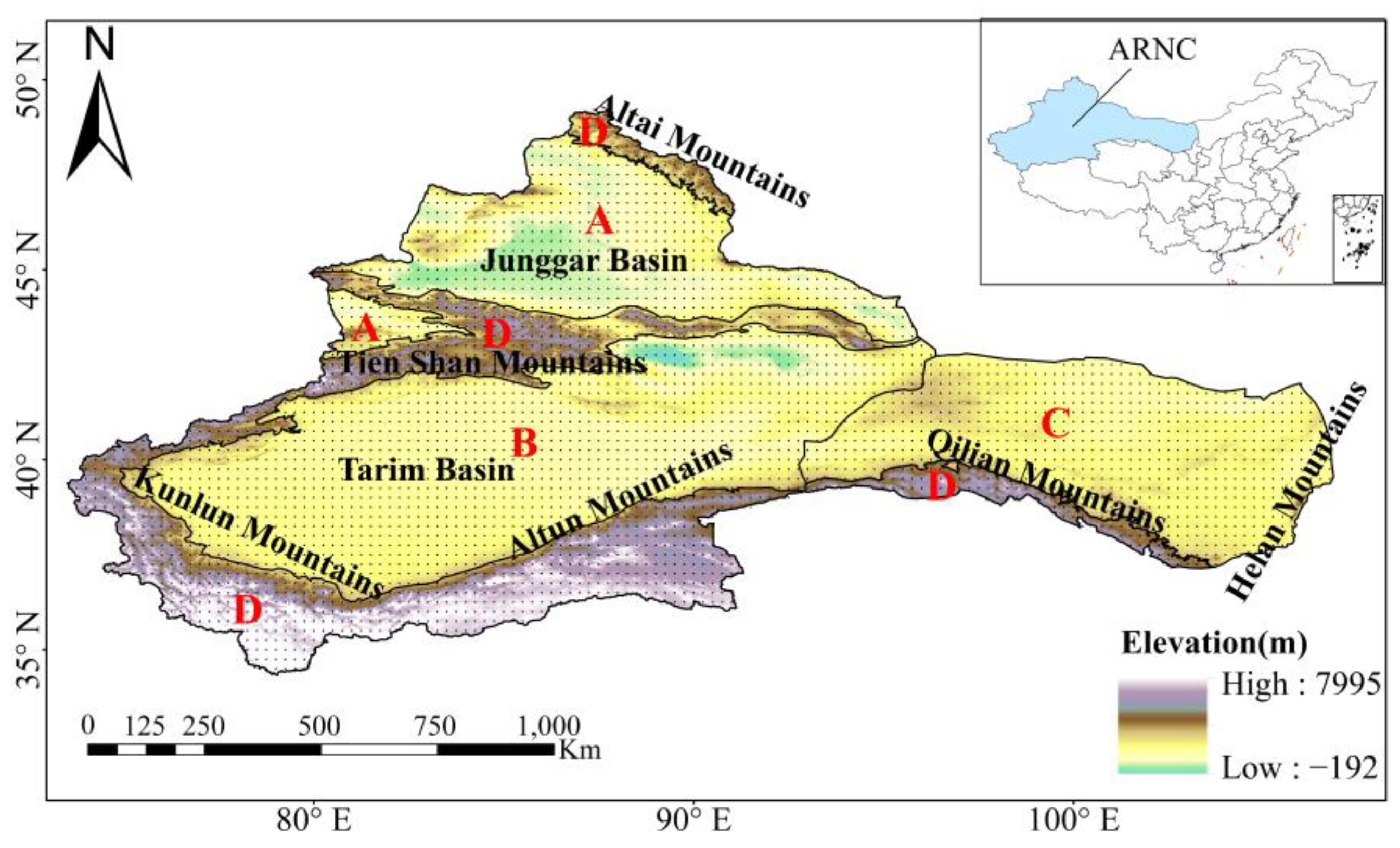
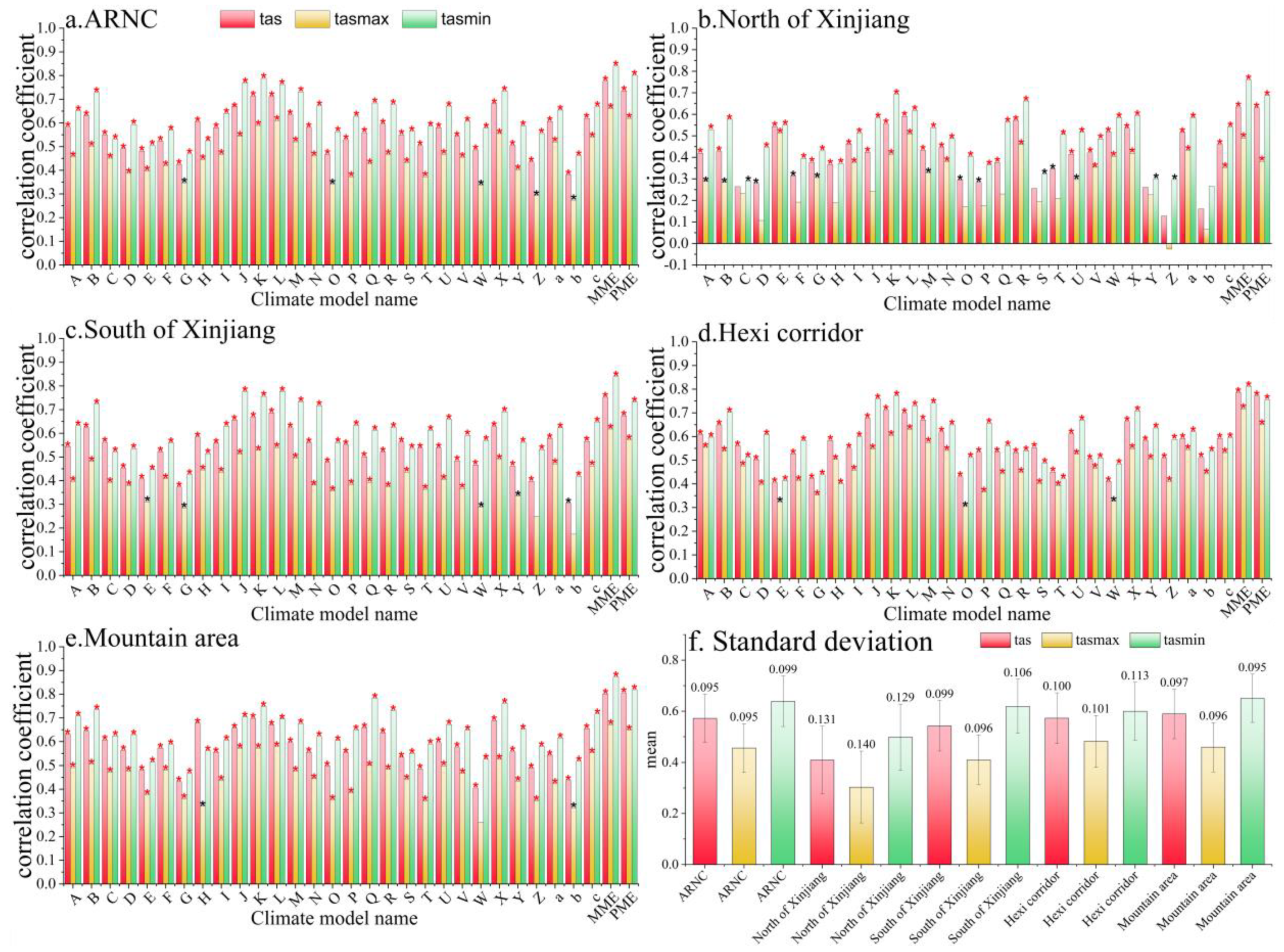

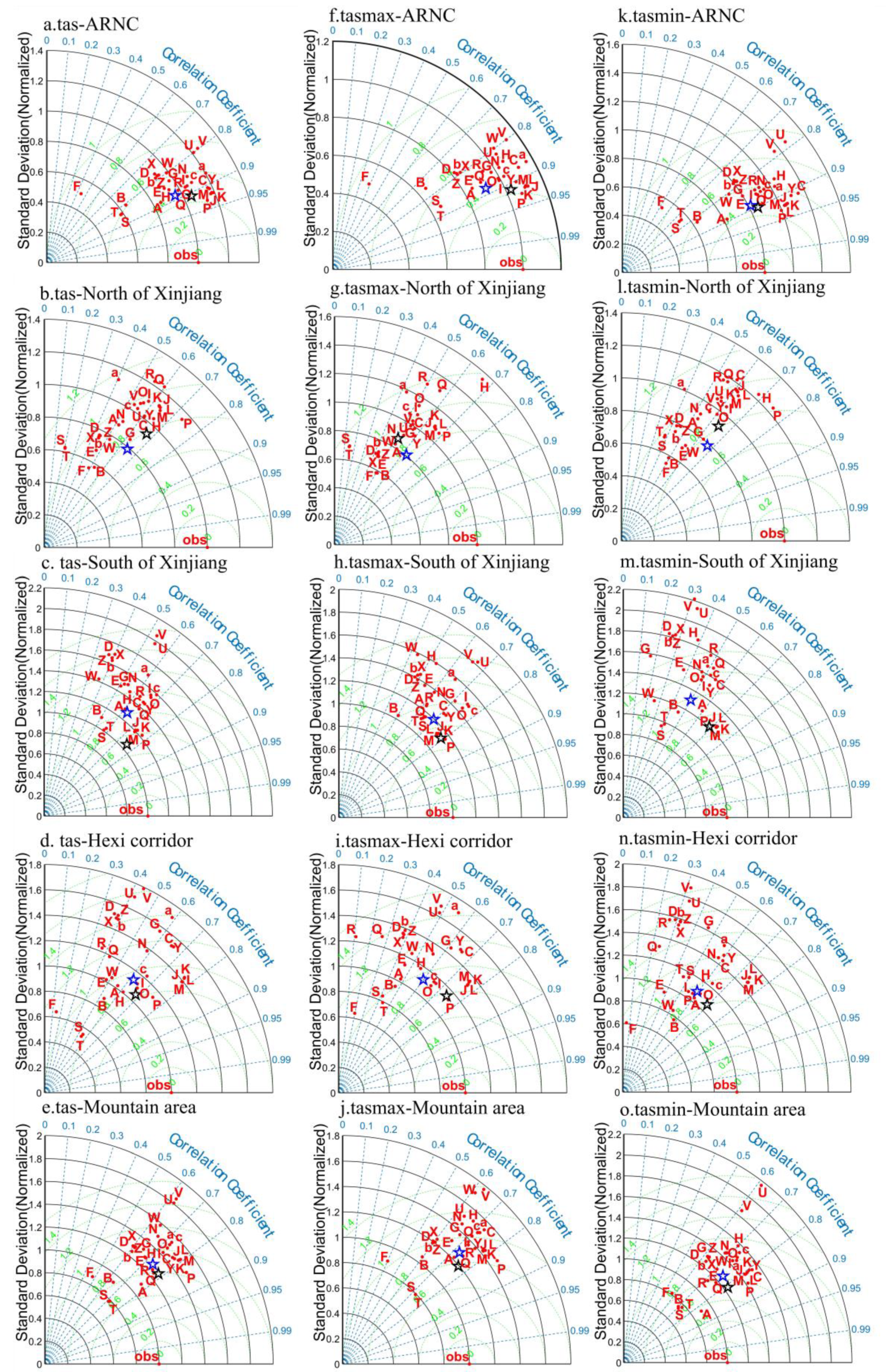
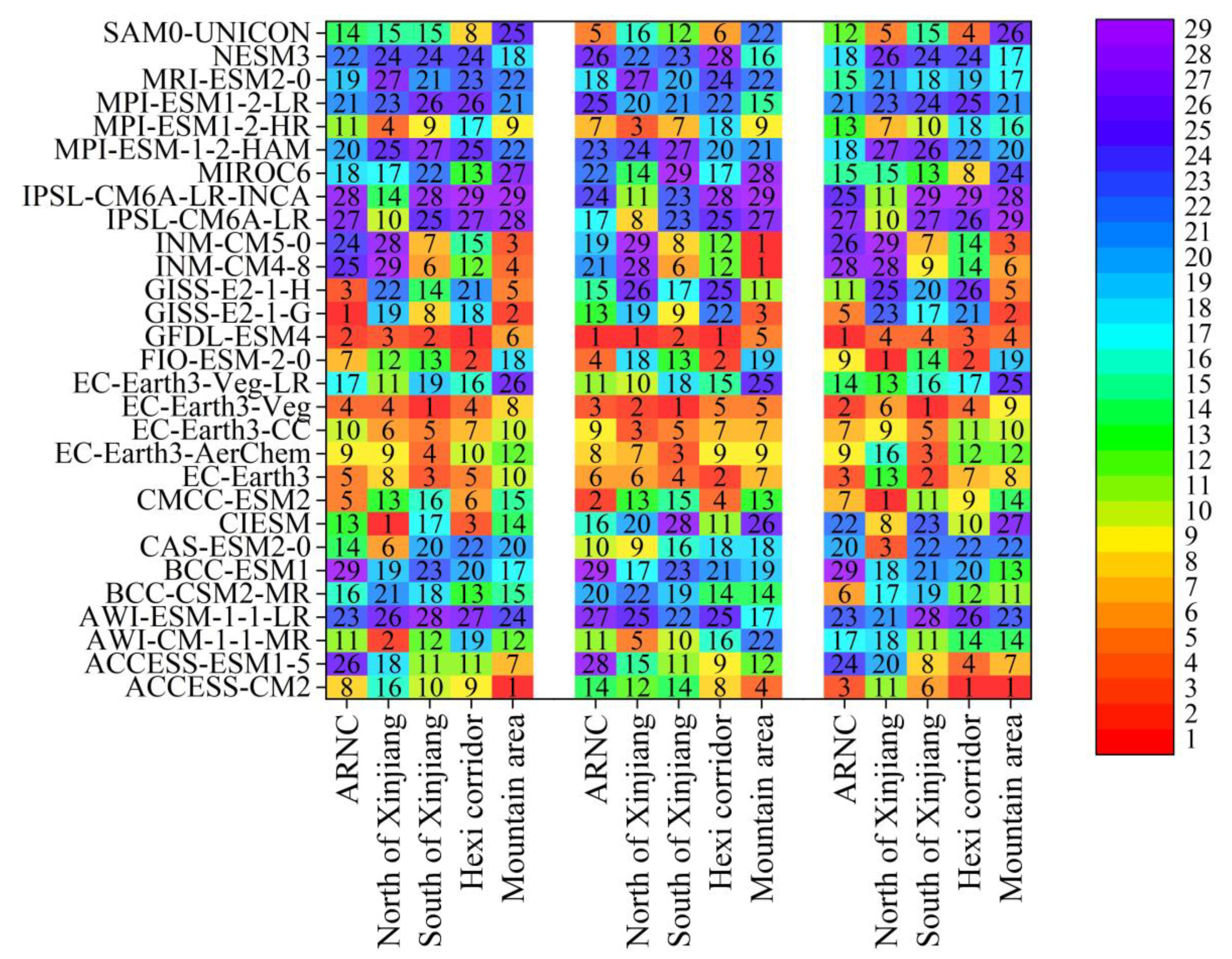
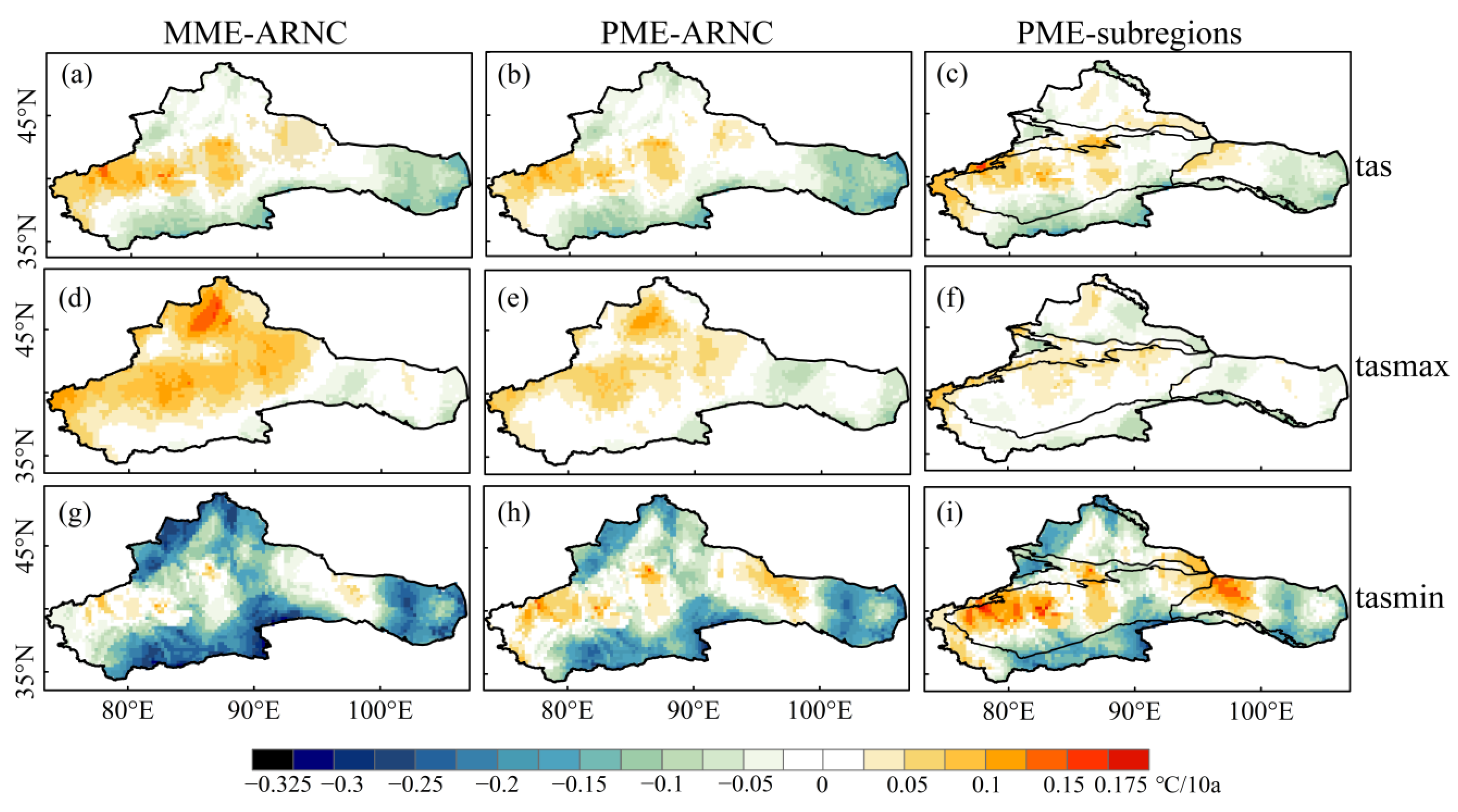
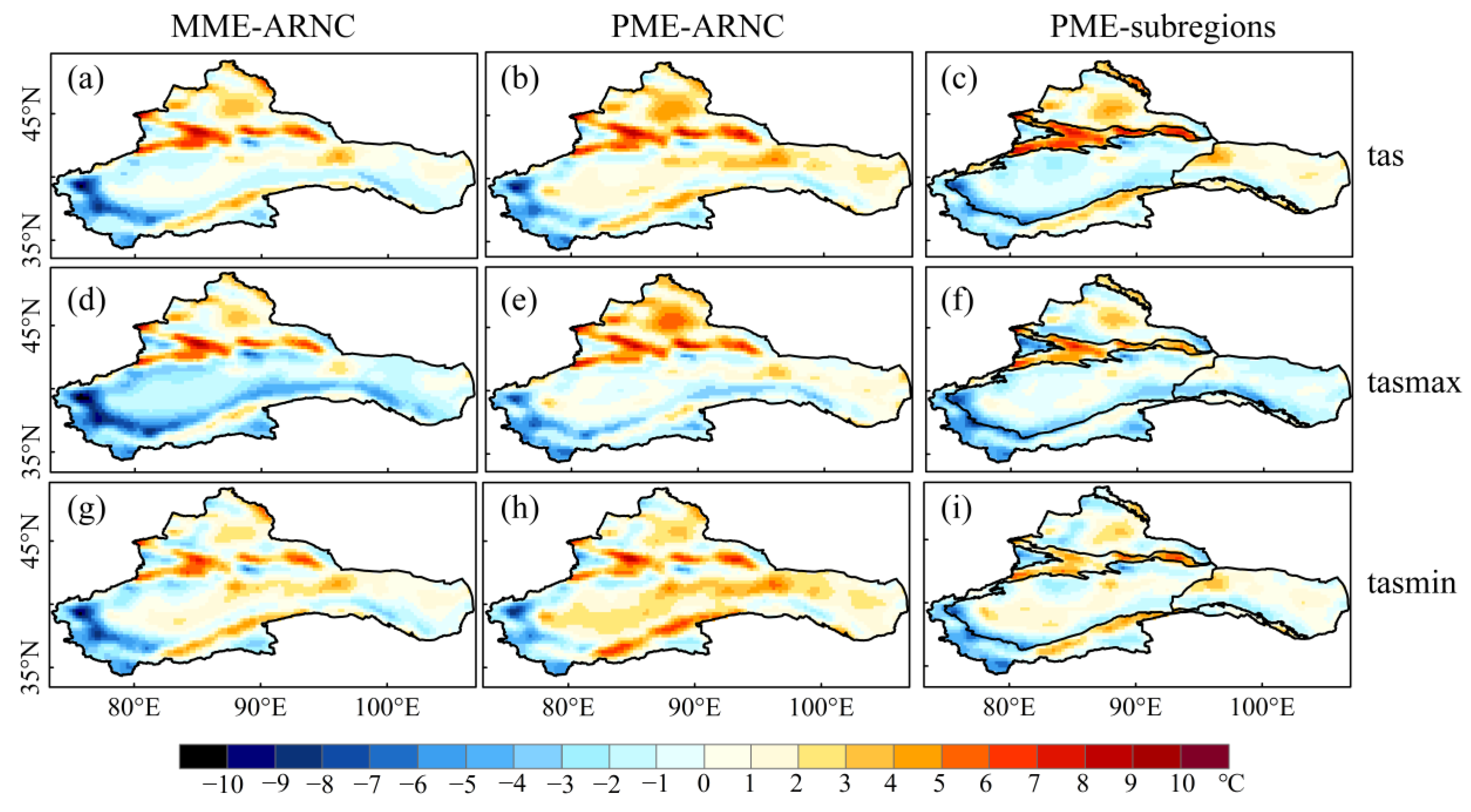
| Abbreviation | Detailed Explanation |
|---|---|
| ARNC | The arid region of northwest China |
| GCMs | Global Climate Models |
| CMIP6 | Phase 6 of the Coupled Model Intercomparison Project |
| PME | Preferred-model ensemble |
| MME | Multi-model ensemble |
| CMIP | Coupled Model Intercomparison Project |
| WRCP | World Climate Research Programme |
| IPCC | Intergovernmental Panel on Climate Change |
| CC | Correlation coefficient |
| tas | Mean Near-surface Air Temperature |
| tasmax | Maximum Near-surface Air Temperature |
| tasmin | Minimum Near-surface Air Temperature |
| RSD | The ratio of standard deviation |
| CRMSE | The normalized centered root-mean-square error |
| Obs | The observation data, CN05.1 |
| Model ID | Model Name | Institution | Country | Resolution | Vertical Levels |
|---|---|---|---|---|---|
| (Lat × Lon) | |||||
| A | ACCESS-CM2 | CSIRO-ARCCSS | Australia | 144 × 192 | L85 |
| B | ACCESS-ESM1-5 | CSIRO | Australia | 145 × 192 | L38 |
| C | AWI-CM-1-1-MR | Alfred Wegener Institute | Germany | 192 × 384 | L95 |
| D | AWI-ESM-1-1-LR | Alfred Wegener Institute | Germany | 96 × 192 | L47 |
| E | BCC-CSM2-MR | Beijing Climate Center | China | 160 × 320 | L46 |
| F | BCC-ESM1 | Beijing Climate Center | China | 64 × 128 | L26 |
| G | CAS-ESM2-0 | Chinese Academy of Sciences | China | 128 × 256 | L35 |
| H | CIESM | Department of Earth System Science, Tsinghua University | China | 192 × 288 | L30 |
| I | CMCC-ESM2 | Fondazione Centro Euro-Mediterraneo sui Cambiamenti Climatici | Italy | 192 × 288 | L30 |
| J | EC-Earth3 | EC-Earth consortium | Europe | 256 × 512 | L91 |
| K | EC-Earth3-AerChem | EC-Earth consortium | Europe | 256 × 512 | L91 |
| L | EC-Earth3-CC | EC-Earth consortium | Europe | 256 × 512 | L91 |
| M | EC-Earth3-Veg | EC-Earth consortium | Europe | 256 × 512 | L91 |
| N | EC-Earth3-Veg-LR | EC-Earth consortium | Europe | 160 × 320 | L91 |
| O | FIO-ESM-2-0 | FIO-QLNM | China | 192 × 288 | L30 |
| P | GFDL-ESM4 | Geophysical Fluid Dynamics Laboratory | USA | 180 × 288 | L49 |
| Q | GISS-E2-1-G | Goddard Institute for Space Studies | USA | 90 × 144 | L40 |
| R | GISS-E2-1-H | Goddard Institute for Space Studies | USA | 90 × 144 | L40 |
| S | INM-CM4-8 | Institute for Numerical Mathematics | Russia | 120 × 180 | L21 |
| T | INM-CM5-0 | Institute for Numerical Mathematics | Russia | 120 × 180 | L73 |
| U | IPSL-CM6A-LR | Institute Pierre Simon Laplace | France | 143 × 144 | L79 |
| V | IPSL-CM6A-LR-INCA | Institute Pierre Simon Laplace | France | 143 × 144 | L79 |
| W | MIROC6 | Japanese Research Community | Japan | 128 × 256 | L81 |
| X | MPI-ESM-1-2-HAM | Max Planck Institute for Meteorology | Germany | 96 × 192 | L47 |
| Y | MPI-ESM1-2-HR | Max Planck Institute for Meteorology | Germany | 192 × 384 | L95 |
| Z | MPI-ESM1-2-LR | Max Planck Institute for Meteorology | Germany | 96 × 192 | L47 |
| a | MRI-ESM2-0 | Meteorological Research Institute | Japan | 160 × 320 | L80 |
| b | NESM3 | Nanjing University of Information Science and Technology | China | 96 × 192 | L47 |
| c | SAM0-UNICON | Seoul National University | Korea | 192 × 288 | L30 |
| Regions | Tas | Tasmax | Tasmin |
|---|---|---|---|
| ARNC | C, G, H, I, M (L), O, P, R (Q), Y, c | C, M (N), P, Q, Y, c | A, I, J (K, L, M), O, R, c |
| North of Xinjiang | G, H, I, L (M), V (U) | N (L) | A, I, J (L, M), U, c |
| South of Xinjiang | M (L), P, S (T) | C, P, Q, S (T), c | A, M (L) |
| Hexi corridor | A, B, H, I, L (J, M), c | I, M (L), P, c | A, B, J (M), c |
| Mountain area | A, B, C, H, L (J, M), P, Q (R), Y | B, E, M (L), P, Q (R), S (T), Y | A, C, I, J (K, L), R |
Publisher’s Note: MDPI stays neutral with regard to jurisdictional claims in published maps and institutional affiliations. |
© 2022 by the authors. Licensee MDPI, Basel, Switzerland. This article is an open access article distributed under the terms and conditions of the Creative Commons Attribution (CC BY) license (https://creativecommons.org/licenses/by/4.0/).
Share and Cite
Liu, F.; Xu, C.; Long, Y.; Yin, G.; Wang, H. Assessment of CMIP6 Model Performance for Air Temperature in the Arid Region of Northwest China and Subregions. Atmosphere 2022, 13, 454. https://doi.org/10.3390/atmos13030454
Liu F, Xu C, Long Y, Yin G, Wang H. Assessment of CMIP6 Model Performance for Air Temperature in the Arid Region of Northwest China and Subregions. Atmosphere. 2022; 13(3):454. https://doi.org/10.3390/atmos13030454
Chicago/Turabian StyleLiu, Fang, Changchun Xu, Yunxia Long, Gang Yin, and Hongyu Wang. 2022. "Assessment of CMIP6 Model Performance for Air Temperature in the Arid Region of Northwest China and Subregions" Atmosphere 13, no. 3: 454. https://doi.org/10.3390/atmos13030454
APA StyleLiu, F., Xu, C., Long, Y., Yin, G., & Wang, H. (2022). Assessment of CMIP6 Model Performance for Air Temperature in the Arid Region of Northwest China and Subregions. Atmosphere, 13(3), 454. https://doi.org/10.3390/atmos13030454






